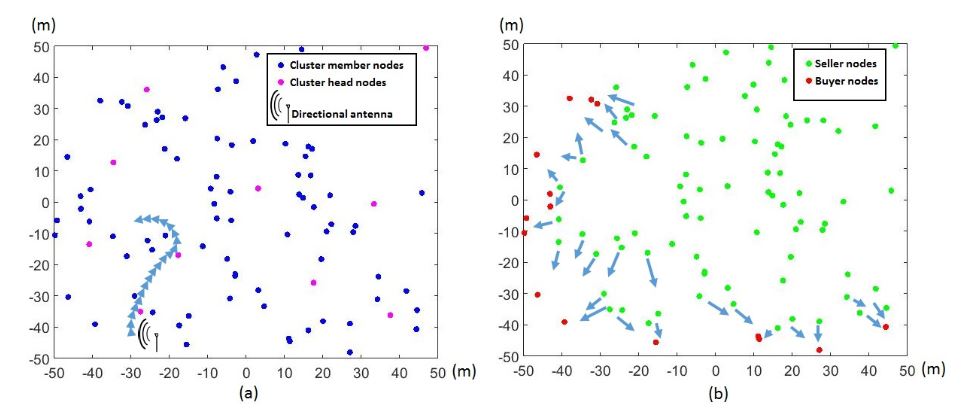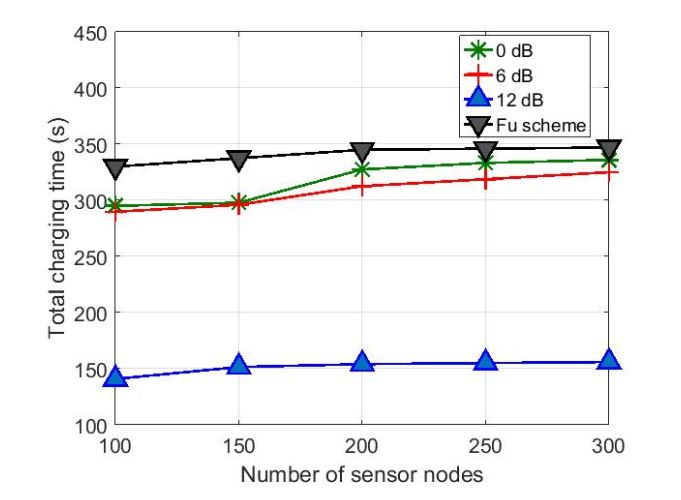ABSTRACT
Provision of energy to wireless sensor networks is crucial for their sustainable operation. Sensor nodes are typically equipped with batteries as their operating energy sources. However, when the sensor nodes are sited in almost inaccessible locations, replacing their batteries incurs high maintenance cost. Under such conditions, wireless charging of sensor nodes by a mobile charger with an antenna can be an efficient solution.
When charging distributed sensor nodes, a directional antenna, rather than an omnidirectional antenna, is more energy-efficient because of smaller proportion of off-target radiation. In addition, for densely distributed sensor nodes, it can be more effective for some undercharged sensor nodes to harvest energy from neighboring overcharged sensor nodes than from the remote mobile charger, because this reduces the pathloss of charging signal due to smaller distances.
In this paper, we propose a hybrid charging scheme that combines charging by a mobile charger with a directional antenna, and energy trading, e.g., transferring and harvesting, between neighboring sensor nodes. The proposed scheme is compared with other charging scheme. Simulations demonstrate that the hybrid charging scheme with a directional antenna achieves a significant reduction in the total charging time required for all sensor nodes to reach a target energy level.
HYBRID CHARGING SCHEME

Figure 1. Two stages of the hybrid charging scheme: (a) charging by mobile charger in the first stage; and (b) energy trading between seller and buyer nodes in the second stage
Figure 1a depicts the situation in the first stage involving the mobile charger and the distribution of cluster heads. Figure 1b shows the initial distribution of seller and buyer nodes when the second stage begins. Unlike the mobile charger, which sojourns at optimal spots without specifying the transition pattern, the mobile charger considered in this work travels while charging. The mobile charger transmits constant RF power during its travel.

Figure 3. Directive gain g A (φ) of different types of directional antennas according to the orientation angle φ
Figure 3 presents the radiation patterns of the different types of directional antennas used in this work. The 6 dB antenna gain is obtained by a helical antenna and the 12 dB antenna gain is obtained with a patch array antenna. Note that the directive gain in dB in Figure 3 is relative to the implicit transmit antenna gain in (2a). Helical antennas are known for their high directivity and circular polarization, and patch array antennas have many advantages including low cost, light weight, and low profile.
SIMULATION RESULTS

Figure 9. Variation of total charging time according to number of sensor nodes with different antenna gains
Figure 9 shows the total charging time Ttot for the hybrid charging scheme with the charging efficiency Tf = 0.05 compared with the results. It is seen in Figure 9 that the hybrid charging scheme is more advantageous than that in terms of charging time. Considering that the Ttot of the hybrid charging scheme includes the time taken for energy trading, the total amount of energy provided by the mobile charger to the sensor network is significantly smaller to achieve the same ETs for all the sensor nodes.

Figure 11. Percentage of time for energy trading over to tal charging time with different antenna gains and charging efficiency
Figure 11 presents the proportion of total charging time used for energy trading. With Tf = 0.05, the proportion of time for energy trading is increased with the higher antenna gain, as expected. That is, with 12 dB antenna gain, the proportion is approximately 10% higher than that with 0 dB antenna gain for NT = 100, and it decreases with increasing NT.
CONCLUSIONS
The main advantage of the proposed hybrid charging scheme is the division of the entire charging process into two stages: charging by the mobile charger and energy trading for balancing. The mobile charger is only concerned with the cluster heads, and thus moves over a shorter path, consequently spending less time for charging. During energy trading, since there are more seller nodes than buyer nodes, energy transfer is performed through many-to-one correspondences. The many-to-one correspondences enable all the sensor nodes in the wireless sensor network to be charged over the target level in a relatively short time.
The impact of higher antenna gain is beneficial for reducing the time needed to charge the cluster heads, but subsequently increases the proportion of time needed for energy trading. Nevertheless, the proportion of time needed for energy trading is considerably smaller than the time required for charging by the mobile charger, providing a significant reduction with higher antenna gain in total charging time as well as total charging energy.
Authors: Celso Moraes | Sunghee Myung | Sangkeum Lee | Dongsoo Har
>> More Wireless Sensor Networks Projects Abstract for Engineering Students
>> More Wireless Energy Projects for Final Year Students